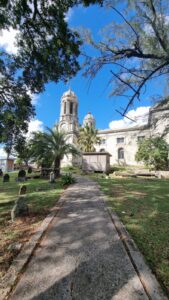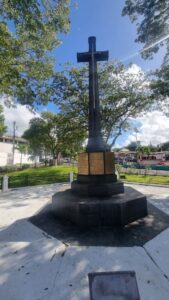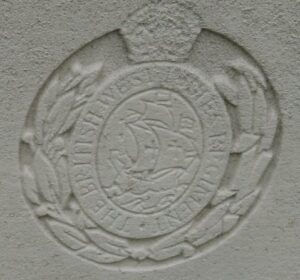Antigua and Bardua War Memorial

St John’s Cathedral, Antigua © K Sklinar 2021
I think in some respects my children know me too well! A set of images of a war memorial were attached to a message. Followed shortly after by images of the war memorial, images of a cathedral and a tomb appeared. The memorial remembers those who fought in World War One on the islands of Antigua and Barbuda. Though the dark stone memorial has six sides, only three are used. One is in the memorial brass plaque, and one brass panel on each side shows the names. A further small plaque commemorates six islanders from the 1939-1945 conflict.
Before I tell you about the young men whose names are on this memorial, let me give you some background information.
The memorial was erected in 1919 and honours 24 young men. During this period, 1914-1918, over 16,000 men and women volunteered to serve. A new regiment, the British West Indian Regiment (BWI Regiment), was formed in October 1915. A large number of men from the islands, joined this regiment, while others joined existing regiments.

Antigua and Barbuda War Memorial © K Sklinar 2021
Returning to the men who are listed alphabetically on the memorial.
Dennis John Freeland Bradbury is first on my list. He was born in Antigua in 1898, the son of Patric Joseph O’Leary Bradbury and his wife Ellen Mary Freeland. Ellen and Patrick are both originally from England, but Patrick’s job required them to move abroad. Oxford-educated Patrick served as Second Master at Antigua Government School. Later Inspector of Schools in Jamaica, followed by Director of Education.
Dennis and his younger brother Basil, in 1911, were living with their aunt and uncle, Georg Henry and Mary Ann Doggett, at Abbey House, Cambridge. Were they here to be educated?
The Southport Visitor opened up a window on the young Dennis on the 30th of November 1916. Denis’s uncle, Dr J. A. Bradbury, former union medical officer for Wigan, wrote that he attended the Moravian School, Leeds (Fulneck School) and later Cambridge University.
In the midst of the Great War, Dennis joined the King’s Own Royal Lancaster Regiment, later the North Lancaster Regiment.
Dennis was wounded in 1916 and taken to a base dressing station where he died, aged 19, on the 15th of November 1916. He rests in Mailly Wood CWGC Cemetery, Picardie. The UK Army Register of Soldiers’ Effects shows a considerable amount of money to be paid to his family.
The base of his headstone are the words “To live in the hearts we leave behind is not to die!.
On the memorial, James Harvey Bryson is listed as the second name. James Bryson was the only child of Robert and Isobel Bryson of Antigua. He was born on the 12th of May 1899. De Ruvigny’s Roll of Honour 1914-1919 includes an interesting biography for James.
Initially educated at Kenley School, time at Aldenham School followed At Aldenham, James took part in both football and athletics and was a senior cadet in the O.T.C. On leaving time at school he joined the army. He was Gazetted 2nd Lieutenant in the R.F.A., in June 1918 and served with the Expeditionary Force in France and Flanders in August of that year. A few months later he was Killed in Action near Cambrai on the 20th of October 1918 aged 19. James rests in Cambrai East Military Cemetery. Information in a booklet held at the cemetery tells that James served with “Y” 24th Trench Morter Battery and that his parents at this time lived at Dunmara, Bourne End, Buckinghamshire.
Like the previous officer, James’ family would receive a considerable amount of money owed for services. James’ name is included in the Aldenham School War Memorial, as well as the list of Ireland’s World War I Casualties 1914-1922, and as we know the Antigua memorial.
In April 1919, Probate for James of 113 Landsdowne Place, Hove, Sussex, was granted to Robert Bryson, Esq., with effects totalling £270.
As well as having his own grave, James is included on that of his grandfather, James M Bryson in, New Calton Cemetery, Edinburgh. The burial place of James M Bryson who died 6th January 1894 aged 69 years. Mary Dunn his wife died 30th August 1902 aged 67 years. James died 3rd Jany 1870 aged 9 months. Jessie Gillespie died 2nd Sept 1875 aged 15 years. Maggie Bannatyne died 27th May 1880 aged 21 years and in proud and loving memory of James Harvey Bryson 2nd Lt. RFA who fell in action in France on 20th Octr 1918 aged 19 years interred at East Cambrai son of Robert Bryson Antigua and grandson of the above James M Bryson. David Dunn Bryson died 26th Jany 1933(?) aged 77 years, Mary Dunn Bryson widow of Peter Bonthron died 30th April 1938 aged 75 years”.
The Scotsman Saturday 20 October 1923 remembers James – “In proud and loving memory of James Harvey Bryson, Lieut., R.F.A., killed in action on the 20th October 1918, aged 19, only and dearly beloved son of Robert Bryson, Antigua, B.W.I., and “Dunmara”, Bourne End, Bucks., and grandson fo the late James M Bryson, Inverleith Row, Edinburgh. “Eternal honour give to those who died in that full splendour of heroic price that we might live”. There is also a mention of James on his parents’ gravestone in Hove Cemetery, Old Shoreham Road, Hove.
The third name on the memorial and the final name for this section is that of Ernest Brooks.
Ernest born around 1892, was the son of William Brooks of Sea View Farm, Antigua. Sea View Farm is a township located in the parish of St George – located approximately halfway between the capital city of St John’s and the island’s largest reservoir, Potworks Dam.

British West Indies insignia on CWGC headstone
Ernest served in the BWI (British West Indies Regt.,)9th Battalion, as Private 11847 from roundabout July 1917. Ernest was injured and taken to No 4 CCS (Casualty Clearing Station) where he died on the 5th of October 1917. Dozinghem Military Cemetery is the final resting place of our young soldiers and over 3,300 others. These soldiers are made up of Commonwealth soldiers from both world wars including those from the Allied withdrawal from Dunkirk and 65 German war graves.
The website Lives of the First World War includes information that Ernest’s medals were not claimed. Monies owing to Ernest, according to the Army Register of Soldiers’ Effects, were sent by Crown Agents to an Antiguan bank account. Another entry for Ernest in the same collections has differing amounts of money being paid to his father, William – this time via the Colonial Society, Antigua.
This link of how to research a BWI soldier may be of interest
Looking for a Caribbean soldier who died in WW1 try this link, Caribbean Roll of Honour,